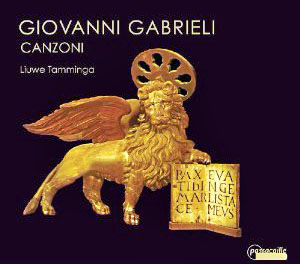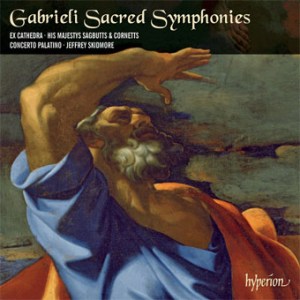 |
 |
|


alternatively
CD: MDT
AmazonUK
AmazonUS
|
Giovanni GABRIELI
(1544/47-1612)
Canzoni
Canzon XXVIII Sol sol la sol fa mi a 8 [2:09]
Canzon francese del duodecimo tono [3:23]
Canzon del duodecimo tono [2:14]
Canzon del duodecimo tono [3:16]
Canzon III a 6 [4:11]
Toccata dell’ottavo tono [2:36]
Ricercar dell’ottavo tono [5:07]
Canzon del secondo tono [2:31]
Motetto Jubilate Deo a 8 [5:14]
Canzon I La Spiritata a 4 [3:15]
Canzon II a 4 del duodecimo tono [2:53]
Canzon III a 4 del duodecimo tono [2:08]
Canzon IV a 4 del duodecimo tono [2:19]
Motetto O Doctor optime a 6 [5:18]
Toccata del primo tono [3:32]
Ricercar del primo tono [3:08]
Sonata I a 5 [3:21]
Canzon del decimo tono [2:15]
Fuga del nono tono [2:33]
Ricercar del decimo tono [4:35]
Canzon del decimo tono [4:08]
Fuga del nono tono [4:25]
Canzon XXVII Fa sol la re a 8 [3:29]
 Liuwe Tamminga (organs), Bruce Dickey, Doron Sherwin (cornetti)
Liuwe Tamminga (organs), Bruce Dickey, Doron Sherwin (cornetti)
rec. San Petronio, Bologna, Italy, 7-9 January 2012. DDD
 PASSACAILLE PAS994 [78:21]
PASSACAILLE PAS994 [78:21]
|
|


alternatively
CD: MDT
AmazonUK
AmazonUS
|
Giovanni GABRIELI
(1544/47-1612)
Sacred Symphonies
Vox Domini super aquas Jordanis C64 [5:52]
In ecclesiis C78 [7:25]
Canzon primi toni a 10 C176 [3:15]
O Jesu mi dulcissime C24 [5:07]
Omnes gentes plaudite manibus C52 [4:01]
O Jesu mi dulcissime C56 [6:21]
Kyrie C71-73 [6:43]
Maria virgo C35 [4:56]
Magnificat C75 [5:38]
Litaniæ Beatæ Mariæ Virginis C63 [12:10]
Exultet iam angelica turba C131 [4:41]
 Ex
Cathedra Ex
Cathedra
His Majestys Sagbutts and Cornetts
Concerto Palatino/Jeffrey Skidmore
rec. All Hallows Church, Gospel Oak, London, 27-29 May 2012. DDD.
Texts and translations included
 HYPERION CDA67957 [66:16]
HYPERION CDA67957 [66:16] |
| |
Two recent and quite different takes on the music of the 16th-century
Venetian composer Giovanni Gabrieli. The Passacaille CD offers
mostly instrumental canzoni, normally performed by cornets
and sackbuts or their modern equivalents - the first recording
that I heard was by the Philip Jones Brass Ensemble - but here
on a pair of historic organs, with the assistance of one or
two cornetti in some of the pieces. In addition organ transcriptions
of two motets are included. The recording was made on the Epistle
and Gospel organs in the church of San Petronio in Bologna,
instruments which date from the late 15th/early 16th
and later 16th century respectively and which give
a fair indication of how the music of the Gabrielis might have
sounded in St Mark’s.
Hyperion offer a programme of vocal music with cornet and sackbut
accompaniment and one canzon at the centre of the programme,
a welcome return from Ex Cathedra and Geoffrey Skidmore and
an equally welcome sequel to His Majesty’s Sagbutts and
Cornetts’ earlier recording of Giovanni Gabrieli’s
instrumental canzoni, interspersed with some organ toccatas
from Timothy Roberts and Richard Egarr on Hyperion CDA66908
[74:52] - from hyperion-records.co.uk
on CD or mp3 or lossless download.
On CDA66908 the predominant tone is provided by the brass instruments
with the organ filling the tone in the background, except on
the toccatas and the intonazione, designed for the organ
alone. On the new Passacaille recording the organs provide the
lion’s share of the sound, with one or both cornets filling
in on five tracks. Overall the sound is less rich but more varied,
since the organist can vary the registration - specified in
each case in the booklet - and, indeed, by using either the
smaller or larger of the two organs. A degree of grandeur is
lost in the process but the performances are persuasive in their
own right.
However it’s performed the music of Giovanni Gabrieli
makes a glorious sound and that’s true of both these recordings
but especially of the Hyperion. To paraphrase Beecham’s
comments on the English attitude to music, even if you don’t
like the music, you’ll love the sound it makes. The music
of the Gabrielis, uncle Andrea and nephew Giovanni, is particularly
colourful and it’s hardly surprising that it influenced
Monteverdi and their joint influence spread as far as Germany
where it coloured the music of Schütz and many of his contemporaries.
Ex Cathedra have already amply proved their ability to do colourful
in three Hyperion recordings of Latin American music of this
period:
- New World Symphonies CDA67380 or CDA30030 - review
- Moon, Sun and all things CDA67524 - review
- Fire burning in snow CDA67600 - review
(all three recordings are included in my survey of Hyperion
Top 30 - review).
The new Hyperion recording is every bit as colourful and enjoyable
as those earlier releases and the works offered add to our knowledge
of Giovanni’s music - only In ecclesiis makes a
regular appearance on other recordings, as, for example, on
the Decca Eloquence reissue of the music of the Gabrielis, The
Glory of Venice, which many will have chosen as an excellent
introduction (448 9932). I compared the new recording with Stephen
Cleobury’s performance of his own arrangement of In
ecclesiis on an earlier (Argo) incarnation of the Eloquence
recording and, while both are good, they are chalk and cheese,
with Cleobury slower, more introspective and dignified at the
beginning and building to a climax and Geoffrey Skidmore offering
a much more colourful approach throughout. There’s a place
for both, as also for the recording from the Taverner Choir
and Players under Andrew Parrott which used to be available
on Virgin, but I think it’s to the new Hyperion that I
shall return most often now. Much as I admire Parrott, his recording
now sounds quite slow and tame by comparison.
The Hyperion recording is available on CD or as a download;
mp3 and 16-bit lossless are available directly from Hyperion
- follow the link above - for £7.99. The 24-bit is a little
more expensive at £12.00 but be aware that this is, unusually,
at 88.2 kHz - some reproducing systems which cope with 24/96
and even 24/192 are stymied by 24/88.2. I listened to the CD-quality
16-bit lossless version and to the physical CD of the Passcaille.
Both are very good.
Both recordings come with excellent documentation - as an Adobe
pdf document if you download the Hyperion. In the case of Hyperion
the excellence is almost a given - and it applies to the earlier
recording from the Sagbutts and Cornetts too - but the Passcaille
is equally informative, including the specifications of the
two organs. The writer, Loris Stella, doesn’t make it
clear that placing the organ foremost in the picture with just
two cornets is the reverse of the normal practice, except in
calling this ‘an unusual selection’ and pointing
to the fact that ‘it was common practice to substitute
available instruments … including … those for ‘da
tasto’ (for keyboards).’
If I were starting from scratch to explore the music of Giovanni
Gabrieli, I’d be inclined to go for the older Hyperion
recording from the Sagbutts and Cornetts, then to move on to
the new Ex Cathedra recording. For those who already have these
or similar collections the Passacaille recording would be a
logical next step. After that it would be time to move on to
the music of Andrea Gabrieli, but that’s a story for another
time.
Brian Wilson
|
|

